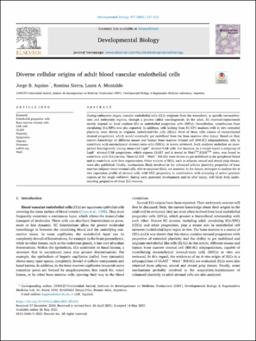| dc.description.abstract | Abstract
During embryonic stages, vascular endothelial cells (ECs) originate from the mesoderm, at specific extraembryonic and embryonic regions, through a process called vasculogenesis. In the adult, EC renewal/replacement mostly depend on local resident ECs or endothelial progenitor cells (EPCs). Nevertheless, contribution from circulating ECs/EPCs was also reported. In addition, cells lacking from EC/EPC markers with in vitro extended plasticity were shown to originate endothelial-like cells (ELCs). Most of these cells consist of mesenchymal stromal progenitors, which would eventually get mobilized from the bone marrow after injury. Based on that, current knowledge on different mouse and human bone marrow stromal cell (BM-SC) subpopulations, able to contribute with mesenchymal stromal/stem cells (MSCs), is herein reviewed. Such analyses underline an unexpected heterogeneity among sinusoidal LepR+ stromal/CAR cells. For instance, in a recent report a subgroup of LepR+ stromal/CAR progenitors, which express GLAST and is traced in Wnt1Cre;R26RTom mice, was found to contribute with ELCs in vivo. These GLAST + Wnt1+ BM-SCs were shown to get mobilized to the peripheral blood and to contribute with liver regeneration. Other sources of ELCs, such as adipose, neural and dental pulp tissues, were also published. Finally, mechanisms likely involved in the enhanced cellular plasticity properties of bone marrow/adipose tissue stromal cells, able to originate ELCs, are assessed. In the future, strategies to analyze the in vivo expression profile of stromal cells, with MSC properties, in combination with screening of active genomic regions at the single cell-level, during early postnatal development and/or after injury, will likely help understanding properties of these ELC sources.
Keywords: Bone marrow stromal cells; CAR cells; Endothelial progenitor cells; Epigenetics; Exosomes; GLAST; Hypoxia; Plasticity; Wnt1; scRNA-seq. | es |


